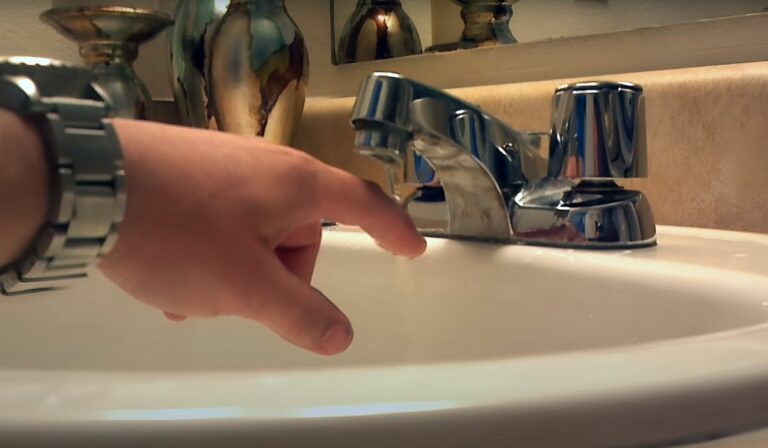How to Turn on a Shower With One Knob
To turn on a shower with one knob, grip the knob firmly and turn it slowly—usually counterclockwise—to start the water flow. Then adjust the same knob left or right to blend hot and cold water until you find your preferred temperature. Push or pull gently if your model controls pressure that way, aiming for steady, comfortable pressure. If you want to avoid sudden temperature changes or weak flow, keep these tips in mind as you explore how your shower works.
Understanding the Single-Knob Shower Mechanism
Although it might seem simple at first, understanding how a single-knob shower works can help you control water temperature and flow more effectively. The single knob combines hot and cold water by adjusting an internal cartridge or valve. When you turn the knob, it moves this cartridge to mix water at different ratios, letting you find your perfect temperature.
Pushing or pulling the knob often controls the water pressure or flow rate. Because these mechanisms vary slightly by brand or model, knowing how your specific knob reacts to turning or pulling makes a big difference. This understanding prevents sudden temperature changes and gives you smoother control, so you won’t waste water or get shocked by unexpected hot or cold bursts while showering.
Locating and Turning the Knob to Start Water Flow
Before you can adjust the temperature, you need to locate the shower knob, which is usually positioned at a comfortable height on the wall. It’s often circular or slightly oval and may have markings indicating hot and cold.
Once you find it, grasp the knob firmly. To start the water flow, turn the knob gently in one direction—usually counterclockwise. You’ll feel resistance at first, but keep turning until water begins to flow from the showerhead.
If nothing happens, try turning it the opposite way, as some models operate differently. Remember to turn slowly to avoid sudden bursts of water.
Once you hear and feel the water running, you’re ready to move on to adjusting the temperature, ensuring a comfortable shower experience.
Adjusting Water Temperature With One Knob
Once the water is flowing, you can adjust the temperature by turning the same knob. Typically, turning the knob to the left increases the hot water, while turning it to the right adds cold water. Make slow, small adjustments to avoid sudden temperature spikes.
If you want warmer water, gently rotate the knob toward the hot side until it feels comfortable. For cooler water, turn it toward the cold side. Pay attention to the temperature as you adjust to prevent burns or chills.
If your knob has markings, use them as guides. Remember, the key is to find a balance that suits your preference without overcorrecting. With a little practice, adjusting the temperature will become second nature.
Tips for Achieving the Perfect Water Pressure
When you turn the knob to start your shower, the water pressure plays a crucial role in your overall experience. To achieve the perfect pressure, begin by slowly turning the knob to balance flow and temperature.
If the pressure feels weak, check if any aerators or shower heads are clogged and clean them regularly. You can also adjust the knob more gradually to avoid sudden surges.
Installing a pressure-balancing valve can help maintain consistent pressure even when other water sources are in use. Remember, your home’s plumbing system affects pressure, so avoid running multiple water fixtures simultaneously.
Troubleshooting Common Single-Knob Shower Issues
Even with perfect water pressure, your single-knob shower can sometimes act up. If the water doesn’t turn on smoothly, check if mineral buildup is blocking the valve. You can remove the knob and clean the cartridge with vinegar to clear deposits.
If the temperature fluctuates unexpectedly, your mixing valve might be faulty or worn out, requiring replacement.
A knob that’s hard to turn often means the cartridge needs lubrication or cleaning.
In cases where water flow is weak despite good pressure, inspect the showerhead for clogs and clean it thoroughly.
If problems persist after basic fixes, it’s wise to call a plumber. Regular maintenance will keep your single-knob shower working flawlessly and prevent issues from escalating.
Frequently Asked Questions
Can I Install a Single-Knob Shower Myself?
Yes, you can install a single-knob shower yourself if you’re comfortable with basic plumbing. Just make sure to turn off the water, follow the instructions carefully, and have the right tools ready before starting.
What Tools Are Needed to Replace a Shower Knob?
You’ll need a screwdriver, Allen wrench, plumber’s tape, and possibly pliers. Make sure to turn off the water first. Having a utility knife and a replacement knob ready will also help streamline the process.
How Do I Clean and Maintain a Single-Knob Shower?
You clean your single-knob shower by wiping the knob and surrounding area with a mild cleaner weekly. Maintain it by checking for leaks, tightening screws, and lubricating the valve annually to keep it smooth and functional.
Are Single-Knob Showers More Water-Efficient?
Single-knob showers can be more water-efficient since you quickly adjust temperature and flow, reducing wasted water. You’ll save water if you get used to turning it off promptly once the temperature feels right.
What Brands Offer Reliable Single-Knob Shower Systems?
You’ll find reliable single-knob shower systems from brands like Moen, Delta, Kohler, and Grohe. They offer durable, stylish options with smooth temperature control and water efficiency, ensuring a hassle-free shower experience you’ll appreciate daily.
Conclusion
Now that you know how to use your single-knob shower, turning it on and adjusting the temperature will feel effortless. Just locate the knob, turn it to start the water flow, and fine-tune the temperature by adjusting the direction. Remember to pay attention to water pressure for a comfortable shower experience. If you run into any issues, don’t hesitate to troubleshoot common problems. With a little practice, your single-knob shower will work perfectly every time.

